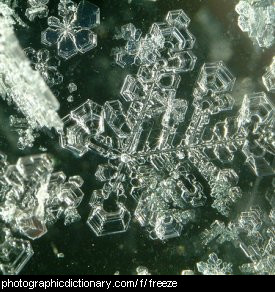Something floats if you put it on the top of a liquid like water and it stays on the top.
Things float because they are less dense than the liquid they are in. For example, the duck in the picture floats because the amount of duck that is below the water level weighs less than the amount of water that would be where the duck is - a concept called displacement.
If you are in a swimming pool with a foam kickboard that floats, try holding it under the water. You can also try this with a ping-pong ball or a polystyrene foam ball in a big bowl of water. It is very hard to get something that floats to go under the water, and if you hold it right down and then let it go it might even pop right out of the water! It is this force that holds floating things up.
The opposite of float is sink.
Fis forFocal point
A focal point is where rays of light converge into a single point. The glass inside a magnifying glass is curved so that it bends all the light that goes through it towards a central point. If you move a magnifying glass up and down in the sun, you will find that at a particular distance away the magnifying glass makes a pinpoint of light that is hot enough to set something on fire. This is called the focal point.
Friction is a force that resists against two surfaces sliding across each other. The rougher the surfaces are the more friction they will encounter, and the smoother the surfaces the less friction there will be.
Friction is a very important force, and many of your day to day activities rely on friction. You walk around easily because of the friction between the ground and your feet. When you are on a low-friction surface like ice you will find it hard to walk, and you are likely to fall over.
The man in the picture is able to climb the rope because of the friction between his hands and the rope.
Something is frozen if it has been made so cold that it goes solid. When water is frozen it turns to ice. The photo is of some frozen vegetables.
Gas is a state that substances can be in. Other states substances can be in are liquid and solid. The air around you is a mix of gases, and when you boil water the bubbles are the water itself turning from a liquid into a gas. Helium balloons are filled with another gas that most people are familiar with - helium is lighter than air so helium balloons rise up.
A laser is a light source that either emits or converts emitted light to coherent light. This means that the light from the laser is all going in the one direction, with the light waves in synch.
Lasers have many, many uses in science and medicine. Less powerful lasers are also commonly used in laser pointers for pointing out words on a screen or whiteboard, and used to make light shows in nightclubs, as seen in the picture.
Light is a type of energy that makes you able to see things. Things like light bulbs, candles and the sun emit light.
Things that don't emit light reflect light, which makes you able to see them.












